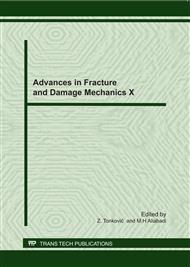p.1
p.5
p.9
p.13
p.17
p.21
p.25
p.29
Development of Predictive Models for Fatigue Crack Growth in Rails
Abstract:
Fatigue failures of rails often occur at the rail foot, since the geometry of this zone gives rise to stress concentrations under service loads or defects during rail manufacture and installation. In this paper, the fatigue behavior of cracks at the web/foot region of a rail is analyzed numerically. Analytical models in the literature for a semi-elliptical surface crack in a finite plate assume that the geometry of the front remains semi-elliptical during the whole propagation phase and the ellipse axes do not undergo translations or rotations. Fatigue tests show that this is not the case for such cracks in rails. A predictive model for crack growth has been developed by assuming an initial small crack at one probable initiation point between the web and foot of the rail in reference to a service condition loading. SIF values have been estimated by means of the finite element method and the plastic radius correction. The results attained were compared with crack growth experimental data.
Info:
Periodical:
Pages:
13-16
Citation:
Online since:
September 2011
Authors:
Keywords:
Price:
Сopyright:
© 2012 Trans Tech Publications Ltd. All Rights Reserved
Share:
Citation:


